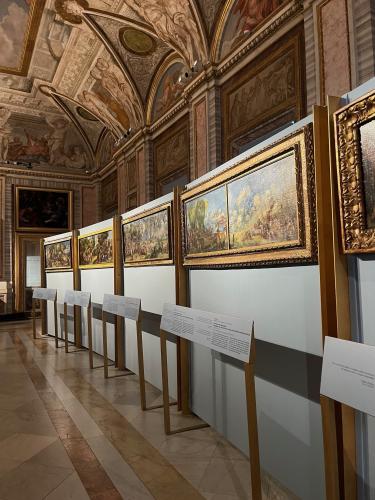Panels from Dosso Dossi’s Renaissance frieze reunited for exhibition at the Galleria Borghese

ROME – An exhibition showcasing five of Dosso Dossi’s ten frieze depicting Virgil’s Aeneid, which have been reunited for the first time, opens at the Galleria Borghese on Tuesday.
Dosso Dossi, born in 1489, was the leading painter in Ferrara in the early 16th century. From 1514 until his death in 1542, Dossi worked for Duke Alfonso d'Este and then Duke Ercole d'Este at the Ferrara court.
The canvases, created between 1518 and 1520, originally decorated Alfonso d’Este’s (the Duke of Ferrara) Alabaster Room. In the first ever exhibition dedicated to this collection, the frieze has been partially reunited thanks to the “ambitious collaboration” between the Louvre Abu Dhabi, the National Gallery of Art in Washington and the Museo del Prado in Madrid.
The frieze, of which only seven canvases have been found to date, was created by drawing inspiration from specific episodes of the Virgilian poem taken from the first, third, fifth and sixth books.
The exhibition includes The Journey to the Underworld which is on loan from a private collection, The Cretan Plague and Sicilian Games in Memory of Anchises and the Founding of a City in Sicily on loan from the Louvre Abu Dhabi, The Arrival of the Trojans at the Strophad Islands and Attack of the Harpies on loan from the Museo del Prado in Madrid and The Construction of the Temple of Venus at Erice and Offerings at the Tomb of Anchises provided by the National Gallery of Art in Washington.
Exhibition curator, Marina Minozzi, described the canvases as being “characterised by vibrant colours, a fascinating eccentricity and originality, making them a brilliant example of the artist’s creativity.”
Dossi’s works previously joined Cardinal Scipione Borghese’s collection in 1608 to decorate his villa and were subsequently split up and relocated at the end of the 18th century. For Scipione, owning the frieze that depicts the story of Aeneas as the founder of Rome, had a profound significance linked to the existence of the papacy and its relationship with the eternal city.
Minozzi, explained the significance of the new exhibition saying that “until the 1990s, we only knew the location of about three of the ten paintings. Now we have located seven.”
Minozzi continued by explaining that two of the known paintings were unfortunately unable to be included in the exhibition. One painting, owned by the National Gallery of Canada has been deemed “too fragile to transport to Italy,” while the other, held by Birmingham’s Barber Institute of Fine Arts doesn’t feature due to “logistical problems.”
Francesca Cappelletti, the exhibition director, expressed her delight at being able to reunite the “magnificent recently resurfaced pieces” and described Dosso Dossi as “a great protagonist of the Italian renaissance.”
The exhibition opens on April 4 and runs until June 11 at the Galleria Borghese.
Ticket information can be found on their website: https://galleriaborghese.beniculturali.it/dosso-dossi-il-fregio-di-enea/
cw

© COPYRIGHT ITALIAN INSIDER
UNAUTHORISED REPRODUCTION FORBIDDEN


